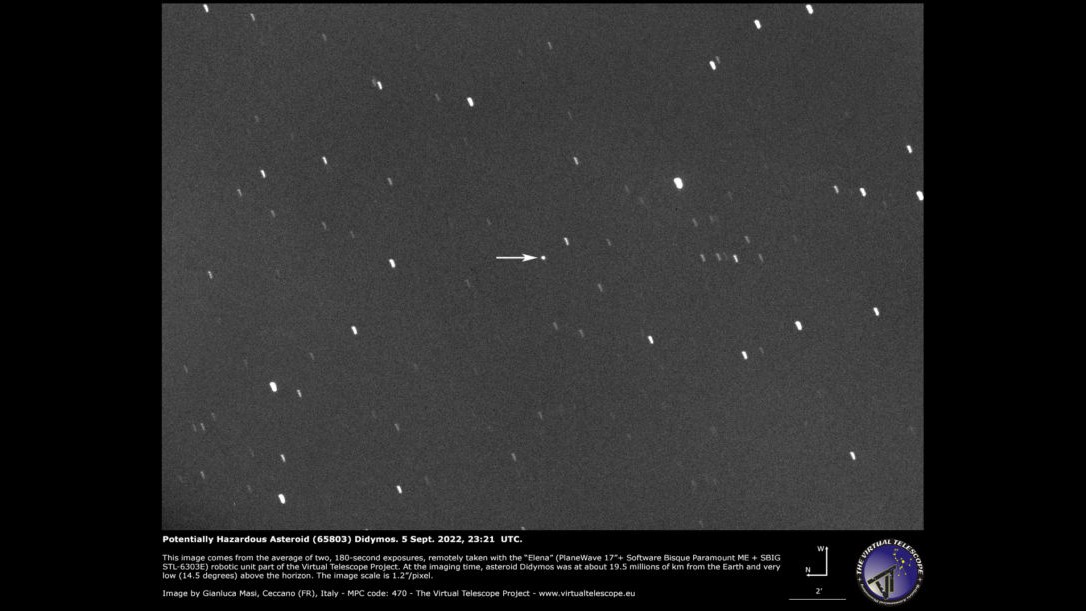NASA will crash a spacecraft into an asteroid on Sept. 26 and you can watch it through telescopes online for free
On Monday (Sept. 26) at 7:14 p.m. EDT (2314 GMT), NASA will intentionally crash a spacecraft into an asteroid — and you might be able to see it live.
The Double Asteroid Redirection Test (DART) is a planetary defense mission designed to test a method of redirecting an Earth-bound asteroid by crashing a spacecraft into it to alter its trajectory. This test mission is targeting the moonlet Dimorphos, a small celestial body orbiting the asteroid Didymos about 7 million miles (11 million kilometers) away from Earth. (This is just a test, and neither Dimorphos nor Didymos poses any threat to our planet.)
While NASA will air live coverage on NASA TV, NASA's website and NASA social media pages, it'll only show the moments leading up to impact. The DART probe's sole instrument, the Didymos Reconnaissance and Asteroid Camera for Optical navigation (DRACO), will beam back approximately one image per second as it approaches its target, which NASA will share both in a dedicated livestream and in a broadcast event.
Related: What time will NASA's DART probe hit an asteroid on Sept. 26?
More: NASA's DART asteroid-impact mission explained in pictures
But the camera will, of course, cease operations when it slams into Dimorphos at a speed of 4.1 miles per second (6.6 km/s). But the Rome-based Virtual Telescope Project hopes to livestream the immediate aftermath of the DART impact in real-time with ground-based telescopes.
Because the Virtual Telescope Project's own telescopes aren't ideally positioned to view the impact, the organization has partnered with two South African observatories: Klein Karoo Observatory, operated by amateur astronomer Berto Monard, and the Mahikeng Astronomical Observatory of the North West University.
The livestream from the telescopes will begin on Monday at 6:30 p.m. EDT (2230 GMT) on the Virtual Telescope Project's website; you can also watch in the window above courtesy of the project.
Breaking space news, the latest updates on rocket launches, skywatching events and more!

The view from the ground based telescopes won't be detailed — the Didymos system is just a point in the sky as seen from Earth — but if all goes according to plan, it might be possible to see increased brightness during and after impact.
For a closer look, we'll have to wait. Earlier this month, DART ejected the Italian Space Agency's Light Italian Cubesat for Imaging of Asteroids (LICIACube), which will fly past the impact site three minutes later. Those images will likely be released within a day or so of impact.
And if you aren't able to tune in live, the Virtual Telescope Project will add its recorded video to its archives.
Follow Stefanie Waldek on Twitter @StefanieWaldek. Follow us on Twitter @Spacedotcom and on Facebook.
Join our Space Forums to keep talking space on the latest missions, night sky and more! And if you have a news tip, correction or comment, let us know at: community@space.com.

Space.com contributing writer Stefanie Waldek is a self-taught space nerd and aviation geek who is passionate about all things spaceflight and astronomy. With a background in travel and design journalism, as well as a Bachelor of Arts degree from New York University, she specializes in the budding space tourism industry and Earth-based astrotourism. In her free time, you can find her watching rocket launches or looking up at the stars, wondering what is out there. Learn more about her work at www.stefaniewaldek.com.
